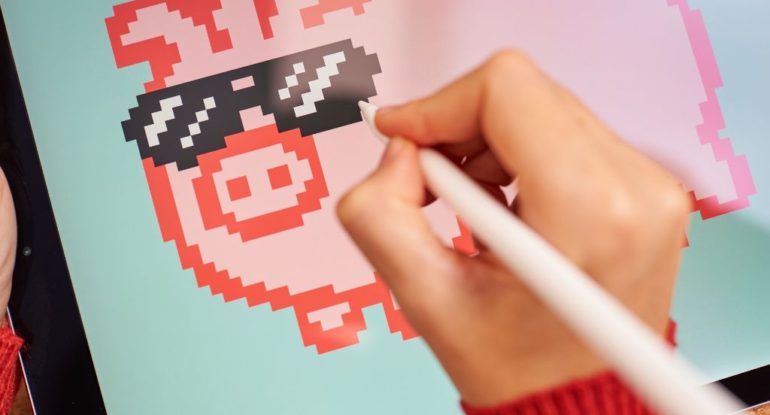The Story Of Amy Kilner- From Graphic Designer to NFT Artist

Amy Kilner worked as a freelance graphic designer for ten years, primarily for advertising firms before she became a renowned NFT artist.
She started creating 2D and 3D NFT art, responding to customers’ requests. When the pandemic hit in 2020, Amy Kilner worked as a graphic designer for ten years, developing designs for events and other projects.
Events were delayed, forcing Kilner, headquartered in Sheffield, United Kingdom, to hunt for employment elsewhere. She decided to work for an agency and began experimenting with 3D ideas. In November 2021, she learned about NFTs from a client and recognized a market for unique designs.
“I started doing 3D drawings two years ago, and the first time someone asked me, “Can you make NFT art?” was in November of last year. Therefore, I began studying it and gradually became engrossed,” said Kilner.
NFTs, or non-fungible tokens, are a new class of virtual assets that, depending on who you ask, may represent the future of art or reckless speculation. They are a digital token that typically links to a work of digital art made by an artist like Amy Kilner but does not necessarily include it. The file may be hosted on a third-party service like Dropbox, but the token is often kept on a blockchain.
There is an enormous spike in demand all of a sudden digital, according to Kilner. “If you consider the things now on the market, people now demand a digital version. They will pay for it and flex if they can have an excellent image to prove that they purchased a Gucci bag or this expensive car.
There are restrictions on NFTs; purchasing one does not imply that you “own” the accompanying work or can prevent others from simply replicating it. Despite some hazards, customers seem eager to give NFT artists millions of dollars worth of cryptocurrency in exchange for copies of original works of art. As wealthy consumers and brands investigate NFTs as the digital equivalent of a rare collectible, there is a gold rush. Although she continues to handle some traditional graphic design work, Kilner started concentrating primarily on NFT art in January.
The Story Of Amy Kilner- From Graphic Designer to NFT Artist https://t.co/uI7rXb0ARc #NFT
— swankyfinance.eth (@swankyfinance) July 20, 2022
She declared, “It’s transformed my career for sure.” “Compared to regular agency work, my earnings have gone through the roof.”
Kilner has earned about £10,000 ($13,376) in two months. She claims she will surpass her agency earnings if she accomplishes her goal of making more than £20,000 in that period.
According to Kilner, who has worked for clients like Warner, Defective Records, and Third Web, most of her work is commissioned by companies. She has ten brand clients that pay her in pounds rather than cryptocurrencies, which is customary for NFTs.
Additionally, she “mints” some of her artwork as NFTs for direct sale in exchange for Ether’s cryptocurrency. Because of the strong demand, artists can afford to charge exorbitant rates. She said that you would pay up to £100,000 to have a whole, unique 3D collection built when people develop extensive 3D collections.
Numerous NFT items could be found in a collection. Only two pieces from Kilner’s Creative Minds collection are for sale, but they are priced at approximately £6,000. The first piece in the collection costs one ethereum, equivalent to £1,973 ($2,641), and the second one costs two ethereum, equal to £3,947 ($5,285). Amy Kilner claimed that she used the exchange platform Coinbase to convert the payments into fiat money. Kilner uses Foundation, an NFT exchange, and claims it costs about £200 ($270) to get her artwork onto Ethereum’s blockchain to mint her NFTs.
This NFT artist primarily learned 3D design on her own.
Amy Kilner claimed she spent a lot of money improving her 3D art creation abilities, including £4,000 ($5,000) on a more powerful PC.
I tend to use Cinema 4D, a popular 3D tool, for everything I’m producing, she said, adding that I utilize the entire Adobe Creative Suite. “I also use Redshift, which handles all the lighting and makes everything appear beautiful and Marvelous Designer, which you can use to create fashion things.
Also, read – A 14-year-old Australian graphic designer created NFT Hooded Eggs
Although the 3D and NFT artist communities shared much advice, the artist primarily trained on her own.
“I’ve definitely put in a lot of effort, and there have been many late nights, particularly to hone the 3D skills. So, in terms of skills, it’s been incredibly difficult, but everyone is still learning in the NFT artist space, she added. “Everyone is still attempting to determine where they sit or fit in. I discovered that everyone is so kind and helpful. One issue artists face the possibility that a mysterious customer could vanish or their work will be stolen because there aren’t many safeguards against this.
Amy Kilner anticipates increased regulation. She claimed that the current demand had allowed her more freedom. In her words, “you have a lot more creative freedom, people trust you, and they allow you a lot more flexibility to develop something that has your own mark on it, because that is more valuable than producing a replica of something else.” “I have a lot more creative freedom now than I ever have in my life,” the speaker said.




























































